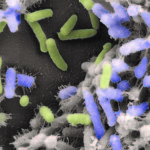Lien vers Pubmed [PMID] – 25437038
Pathogens 2013;2(2):288-356
The influence of microorganisms growing as sessile communities in a large number of human infections has been extensively studied and recognized for 30-40 years, therefore warranting intense scientific and medical research. Nonetheless, mimicking the biofilm-life style of bacteria and biofilm-related infections has been an arduous task. Models used to study biofilms range from simple in vitro to complex in vivo models of tissues or device-related infections. These different models have progressively contributed to the current knowledge of biofilm physiology within the host context. While far from a complete understanding of the multiple elements controlling the dynamic interactions between the host and biofilms, we are nowadays witnessing the emergence of promising preventive or curative strategies to fight biofilm-related infections. This review undertakes a comprehensive analysis of the literature from a historic perspective commenting on the contribution of the different models and discussing future venues and new approaches that can be merged with more traditional techniques in order to model biofilm-infections and efficiently fight them.


